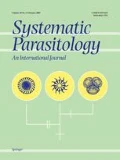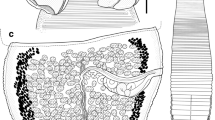Abstract
Between 1993 and 1996, 26 individuals of two species of horn sharks were collected from the upper Gulf of California and their spiral intestines examined for onchobothriid tapeworms. Heterodontus francisci was found to host Acanthobothrium puertecitense n. sp. Based on the criteria of Ghoshroy & Caira (2001), this is a Category 4 species (with >15mm total length, >50 proglottids, >80 testes and a symmetrical ovary). It differs from the four Category 4 species previously reported from either the western Atlantic or eastern Pacific Oceans, including A. bajaense (emend.) which was described from H. francisci, in hook-shape, total length, number of proglottids, number of testes and number of columns of vitelline follicles. H. mexicanus was found to host Acanthobothrium santarosaliense n. sp., which, based on the criteria of Ghoshroy & Caira (2001) is a Category 3 species (with >15mm total length, >50 proglottids, >80 testes and an asymmetrical ovary). A. santarosaliense differs from the five Category 3 species previously reported from either the western Atlantic or eastern Pacific Oceans in its size, euapolytic nature, lack of dark matrix from the bases of the hooks, hook-shape, and distribution and number of testes. In addition to the difference in ovarian symmetry, A. puertecitense possesses fewer testes, fewer proglottids, is a shorter worm, possesses a more anterior genital pore and vitelline follicles which extend further forward anteriorly than in A. santarosaliense. This represents the first report of onchobothriids from H. mexicanus and the first report of onchobothriids from H. francisci in the Gulf of California. The apparent host-specificity of both new species should be viewed with caution until a greater sample of host individuals of both species can be examined. The fact that both new tapeworm species are known only from the Gulf is also considered to be a preliminary result, given the small sample of host individuals examined from these regions to date. This brings the total number of species of Heterodontus known to host Acanthobothrium to four and the total number of Acanthobothrium species described from heterodontiform sharks to five.
Similar content being viewed by others
References
Appy, R.G. & Dailey, M.D. (1973) Two new species of Acanthobothrium (Cestoda: Tetraphyllidea) from elasmobranchs of the Eastern Pacific. Journal of Parasitology, 59, 817-820.
Caira, J.N. (1985) Calliobothrium evani sp. n. (Tetraphyllidea: Onchobothriidae) from the Gulf of California, with a redescription of the hooks of C. lintoni and a proposal for onchobothriid hook terminology. Proceedings of the Helminthological Society of Washington, 52, 166-174.
Caira, J.N. & Burge, A.L. (2001) Three new species of Acanthobothrium (Cestoda: Tetraphyllidea) from the ocellated electric ray, Diplobatis ommata, in the Gulf of California, México. Comparative Parasitology, 68, 52-65.
Caira, J.N., Jensen, K. & Healy, C.J. (2001) Interrelationships among tetraphyllidean and lecanicephalidean cestodes. In: Littlewood, D.T.J. & Bray, R.A. (Eds) Interrelationships of the Platyhelminthes. London: Taylor & Francis, pp. 135-158.
Compagno, L. (1984) FAO species catalogue. VI. 4, Parts 1 and 2: Sharks of the world. An annotated and illustrated catalogue of shark species known to date. FAO Fisheries Synopsis, 125, 655 pp.
Drummond, F.H. (1937) Cestoda. Lady Julia Percy Island. Reports of the expedition of the McCoy Society for Fish Investigations and Research. Proceedings of the Royal Society of Victoria, 49, 401-404.
Euzet, L. (1959) Recherches sur les cestodes tétraphyllides des sélaciens des côtes de France. Docteur és Sciences Naturelles Thèse, Université de Montpellier, Montpellier, France, 263 pp.
Ghoshroy, S. & Caira, J.N. (2001) Four new species of Acanthobothrium (Cestoda: Tetraphyllidea) from the whiptail stingray Dasyatis brevis in the Gulf of California. Journal of Parasitology, 87, 354-372.
Goldstein, R.J. (1967). The genus Acanthobothrium van Beneden, 1849 (Cestoda: Tetraphyllidea). Journal of Parasitology, 53, 455-483.
Prudhoe, S. (1969) Cestodes from fish, birds and whales. Reports of B.A.N.Z. Antarctic Research Expedition, 1929–1930, Series B, 8, 171-193.
Schmidt, G.D. (1986). Handbook of tapeworm identification. Boca Raton: CRC Press, 675 pp.
Williams, H.H. (1969). The genus Acanthobothrium Beneden, 1849 (Cestoda: Tetraphyllidea), Nytt Magasin for Zoologi, 17, 1-56.
Yamaguti, S. (1934) Studies on the helminth fauna of Japan. Part 3. Cestodes of fishes. Japanese Journal of Zoology, 6, 1-112.
Author information
Authors and Affiliations
Rights and permissions
About this article
Cite this article
Caira, J., Zahner, S.D. Two new species of Acanthobothrium Beneden, 1849 (Tetraphyllidea: Onchobothriidae) from horn sharks in the Gulf of California, Mexico. Syst Parasitol 50, 219–229 (2001). https://doi.org/10.1023/A:1012241913722
Issue Date:
DOI: https://doi.org/10.1023/A:1012241913722




